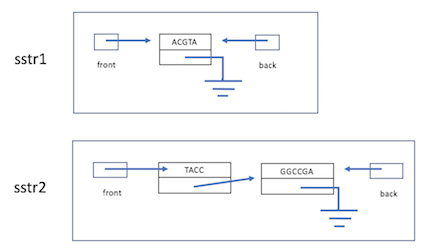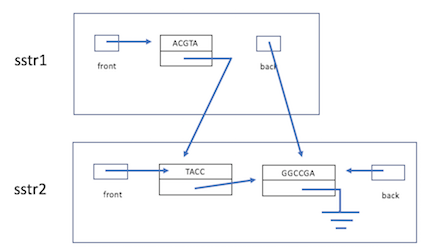
For this assignment, you will implement a SpliceString class that provides much of the functionality of the String class, but utilizes structure sharing in order to optimize splicing. Internally, your SpliceString class should utilize a singly-linked list of strings, with references to the front and back of the list. For example, the sstr1 object below represents the string "ACGTA" using a linked structure with only one node. The sstr2 object represents the string "TACCGGCCGA" using a linked structure with two nodes.

Since objects of the same class are able to view each other's private data, it is possible to splice one SpliceString object onto the end of another without having to copy any strings or nodes. Instead, the links in one are connected to the other, as shown below:

As a result, it is possible to splice one SpliceString object onto the end of another in O(1) time. Likewise, it is possible to splice into the middle of another SpliceString object in better than O(N) time, where N is the number of characters in the string.
Warning: one consequence of structure sharing is that you should never attempt to splice a SpliceString (or any portion of that SpliceString object) onto itself. Otherwise, infinite data structures may result!
Your basic SpliceString class (which will be expanded in HW4) should implement the following constructors and methods:
public SpliceString()
public SpliceString(String str)
str).
public boolean empty()
SpliceString object represents the empty string. Note: this should be O(1).
public int length()
SpliceString object. Note: this should be O(1).
public void splice(SpliceString other)
SpliceString onto the end of this SpliceString object. No new nodes should be created when
splicing - the operation should be accomplished in O(1) time by reconnecting list references.
public void splice(String other)
String onto the end of this SpliceString object. Note: this should also be O(1).
public String toString()
SpliceString object.
As part of your submission, you should include a simple driver class that tests each of these constructors and methods.